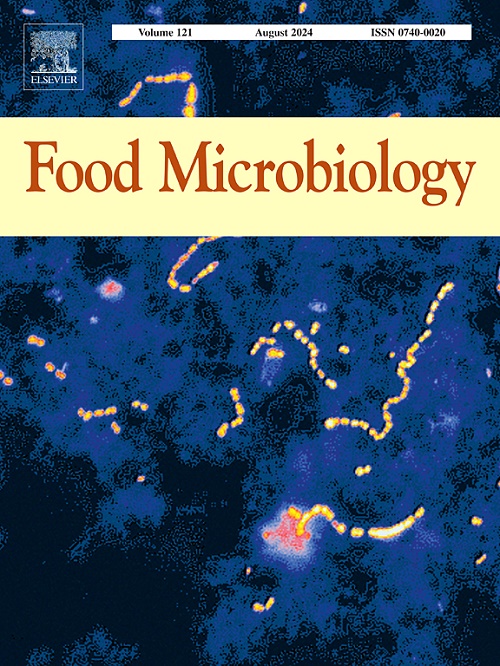用单氮化丙啶(PMA)qPCR 检测法与平板计数法比较,结合数学建模方法量化真空包装火鸡胸脯肉中肠炎沙门氏菌血清型的生长情况
IF 4.5
1区 农林科学
Q1 BIOTECHNOLOGY & APPLIED MICROBIOLOGY
引用次数: 0
摘要
本研究比较了平板计数法 (PC) 和单氮化丙啶定量聚合酶链式反应法 (PMA-qPCR),利用预测模型评估了在等温贮藏温度(8 ℃-20 ℃)下熟制、切片和真空包装火鸡胸脯肉 (STB) 中三种血清型沙门氏菌(海德堡沙门氏菌、鼠伤寒沙门氏菌和肠炎沙门氏菌)的生长情况。为 PMA-qPCR 开发了标准曲线,显示出高效率(101%)和高灵敏度,在所有研究温度下的定量限为 1 至 2 log10 CFU/g。比较分析表明,PC 和 PMA-qPCR 方法之间存在明显的相关性(R2 = 0.99;95% CI);但是,一致性分析表明,两者之间存在-0.11 log10 CFU/g (p < 0.05)的平均差异(偏差),这表明 PC 方法低估了 CFU 的含量。这表明存在受压细胞或有活力但不可培养的细胞(VBNC),PMA-qPCR 可检测到这些细胞,但 PC 检测不到。对于所有等温条件下的 PC 和 PMA-qPCR 数据,Baranyi 和 Roberts 模型都能很好地描述 STB 中肠炎球菌的行为。与 Ratkowsky 平方根模型相比,指数二级模型更准确地表示了最大比生长率的温度依赖性,两种方法的 R2 值均≥ 0.984,RMSE 值均≤ 0.011。这些结果表明,与 PC 方法相比,将 PMA-qPCR 与预测模型相结合可更准确地预测肠杆菌的生长情况。在肉类产品冷链中断的情况下,使用 PMA-qPCR 方法可以对 VBNC 细胞进行定量,而 VBNC 细胞仍会对消费者的健康构成威胁,尤其是在即食产品中。本文章由计算机程序翻译,如有差异,请以英文原文为准。
Propidium monoazide (PMA) qPCR assay compared to the plate count method for quantifying the growth of Salmonella enterica serotypes in vacuum-packaged turkey breast combined with a mathematical modeling approach
This study compares the plate count (PC) and the Propidium Monoazide-quantitative Polymerase Chain Reaction (PMA-qPCR) methods to assess the growth of a cocktail of three serotypes of Salmonella enterica (Heidelberg, Typhimurium, and Enteritidis) in cooked, sliced, and vacuum-packaged turkey breast (STB) under isothermal storage temperatures (8 °C–20 °C), using predictive models. Standard curves were developed for PMA-qPCR, demonstrating high efficiency (101%) and sensitivity, with quantification limits ranging from 1 to 2 log10 CFU/g for all temperatures studied. Comparative analysis revealed a significant correlation (R2 = 0.99; 95% CI) between the PC and PMA-qPCR methods; however, the agreement analysis indicated a mean difference (Bias) of −0.11 log10 CFU/g (p < 0.05), suggesting underestimation by the PC method. This indicates the presence of stressed or viable but nonculturable (VBNC) cells, detectable by PMA-qPCR but not by PC. The Baranyi and Roberts model showed a good ability to describe the behavior of S. enterica cocktail in STB for PC and PMA-qPCR data under all isothermal conditions. The exponential secondary model more accurately represented the temperature dependence of the maximum specific growth rate compared to the Ratkowsky square root model, with R2 values ≥ 0.984 and RMSE values ≤ 0.011 for both methods. These results suggest that combining PMA-qPCR with predictive modeling allows for a more accurate prediction of S. enterica growth, compared to PC method. In the event of cold chain disruptions of meat products, the use of PMA-qPCR method allow the quantification of VBNC cells, that can still pose a health risk to consumers, especially in ready-to-eat products.
求助全文
通过发布文献求助,成功后即可免费获取论文全文。
去求助
来源期刊

Food microbiology
工程技术-生物工程与应用微生物
CiteScore
11.30
自引率
3.80%
发文量
179
审稿时长
44 days
期刊介绍:
Food Microbiology publishes original research articles, short communications, review papers, letters, news items and book reviews dealing with all aspects of the microbiology of foods. The editors aim to publish manuscripts of the highest quality which are both relevant and applicable to the broad field covered by the journal. Studies must be novel, have a clear connection to food microbiology, and be of general interest to the international community of food microbiologists. The editors make every effort to ensure rapid and fair reviews, resulting in timely publication of accepted manuscripts.
 求助内容:
求助内容: 应助结果提醒方式:
应助结果提醒方式:


